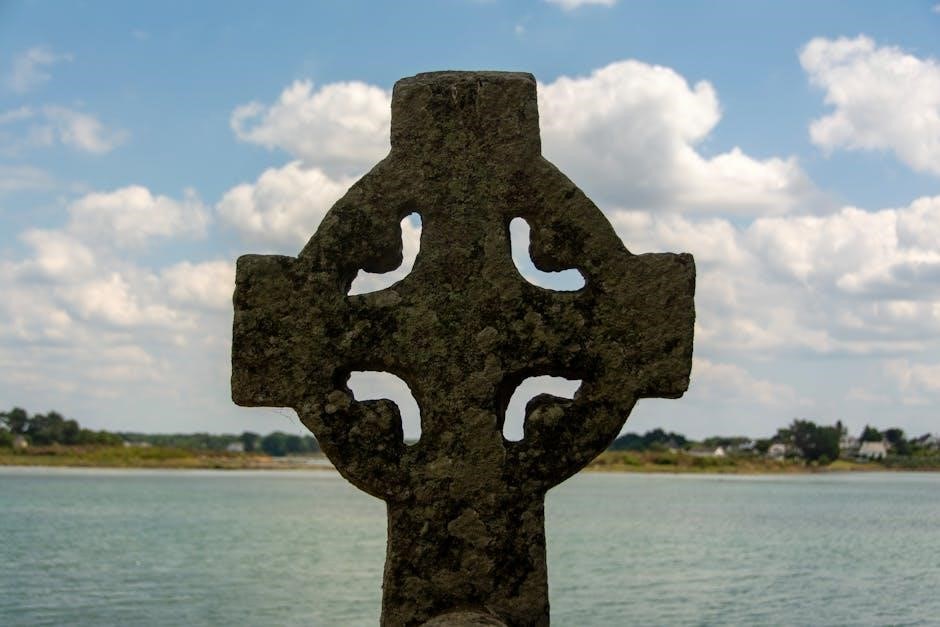
blue bells of scotland trombone pdf
“Blue Bells of Scotland” is a traditional Scottish folk melody‚ famously arranged by Arthur Pryor for trombone‚ offering a timeless piece for musicians to explore and perform․
1․1 Historical Significance and Popularity
“Blue Bells of Scotland” holds a revered place in musical heritage‚ originating as a traditional Scottish folk song․ Its adaptation by Arthur Pryor for trombone elevated its status‚ making it a cornerstone of trombone repertoire․ The piece has been widely performed and admired for over a century‚ with its lyrical melody and technical challenges captivating audiences and musicians alike․ Its enduring popularity is evident in its availability as digital sheet music‚ ensuring accessibility for modern players․ This timeless arrangement bridges cultural and musical traditions‚ maintaining its relevance across generations․
Arthur Pryor and His Arrangement
Arthur Pryor‚ a renowned trombonist and band leader‚ famously arranged “Blue Bells of Scotland‚” adapting the traditional melody into a celebrated trombone solo‚ showcasing his artistry․

2․1 Background of Arthur Pryor
Arthur Pryor was a distinguished trombonist‚ composer‚ and bandleader‚ known for his virtuosic playing and influential arrangements․ Born in 1870‚ he became a prominent figure in the early 20th-century music scene‚ leading notable bands and composing works that remain popular today․
2․2 His Interpretation for Trombone
Arthur Pryor’s arrangement of “Blue Bells of Scotland” for trombone showcases his mastery of the instrument‚ blending technical brilliance with emotional depth․ The piece‚ in F Major‚ features intricate ornaments and cadenzas‚ highlighting Pryor’s virtuosic style․ His interpretation transforms the traditional Scottish melody into a solo showcase‚ emphasizing the trombone’s expressive qualities․ The arrangement remains a cornerstone of trombone repertoire‚ demonstrating Pryor’s ability to balance tradition with innovation․ Its challenging yet rewarding structure has made it a favorite among trombonists seeking to refine their technique and artistry․

Sheet Music Details
The sheet music features Arthur Pryor’s arrangement in F Major‚ including a trombone solo with piano accompaniment․ It spans eight pages‚ offering a classic yet challenging piece for performers․
3․1 Structure and Composition
The sheet music for “Blue Bells of Scotland” is structured as a theme and variations‚ showcasing Arthur Pryor’s masterful arrangement in F Major․ The composition begins with a lyrical introduction of the Scottish folk melody‚ followed by intricate variations that highlight the trombone’s technical and expressive capabilities․ The piece spans eight pages‚ featuring a solo trombone part accompanied by piano․ Pryor’s arrangement includes dynamic contrasts‚ phrasing nuances‚ and ornamental flourishes‚ making it both challenging and rewarding for performers․ The composition’s complexity underscores its enduring popularity in trombone repertoire․
3․2 Notation and Key (F Major)
The sheet music for “Blue Bells of Scotland” is notated in F Major‚ a key that complements the trombone’s rich‚ warm timbre․ The arrangement features clear dynamics‚ phrasing‚ and articulations‚ ensuring precise interpretation․ The solo trombone part is accompanied by a piano‚ with the notation providing detailed expressions to guide performers․ The key of F Major allows for technical agility while maintaining the melody’s lyrical quality․ The PDF versions available on platforms like IMSLP and Musicnotes ensure accessibility for musicians seeking to master this beloved piece‚ with the notation preserving Arthur Pryor’s original intent and musicality․
Availability of the Trombone PDF
The “Blue Bells of Scotland” trombone PDF is widely available on platforms like IMSLP and Musicnotes‚ offering both free and paid versions for convenient access to the sheet music․
4․1 Platforms for Download (IMSLP‚ Musicnotes)
The “Blue Bells of Scotland” trombone PDF is accessible on platforms like IMSLP and Musicnotes․ IMSLP offers a free version‚ scanned by the US-Nau Wilson Music Library‚ providing open access to the sheet music․ Musicnotes‚ on the other hand‚ offers a paid version‚ featuring high-resolution PDFs and the option to use Pro Credits for download․ Both platforms ensure convenient access to Arthur Pryor’s arrangement‚ catering to musicians’ needs for practice and performance․ These digital resources make it easy for trombone players to acquire and utilize the sheet music efficiently‚ regardless of their preferred platform or budget․
4․2 Free vs․ Paid Versions
The “Blue Bells of Scotland” trombone PDF is available in both free and paid versions․ Free versions‚ such as those on IMSLP‚ provide basic sheet music scanned from public domain sources‚ suitable for practice․ Paid versions‚ like those on Musicnotes‚ offer high-resolution PDFs‚ often with additional features such as accompaniment parts and transposition options․ Paid versions ensure professional quality and convenience‚ while free versions cater to budget-conscious musicians․ Choosing between them depends on individual needs‚ with free options ideal for casual use and paid versions preferred for performance or advanced study․

Performance Considerations
Performing “Blue Bells of Scotland” on trombone requires balancing technical virtuosity with melodic expression‚ ensuring the traditional Scottish melody shines through while showcasing the trombone’s capabilities․
5․1 Tips for Trombone Players
When performing “Blue Bells of Scotland‚” trombone players should focus on precise articulation and dynamic control to capture the melody’s lyrical quality․ Emphasize legato phrasing in the slower sections and clarity in the faster passages․ Pay attention to intonation‚ especially in the upper register‚ where the F Major key can present challenges․ Practice the cadenza with careful breath control to maintain a smooth‚ even tone․ Start with a moderate tempo and gradually increase as familiarity grows․ Use a metronome to ensure consistency and work on balancing with the accompaniment‚ whether piano or band․ Prioritize musicality over technical virtuosity to honor the piece’s traditional roots․
5․2 Technical Challenges and Solutions
The trombone arrangement of “Blue Bells of Scotland” presents technical challenges‚ particularly in the upper register and fast passages․ To overcome these‚ focus on precise fingerings and slide accuracy․ Use slow practice to build control in intricate sections․ Intonation can be tricky in F Major; long tones and scales in this key will help․ Breath control is crucial‚ especially in the cadenza; practice deep breathing exercises․ Break challenging phrases into smaller parts and gradually combine them․ Use a metronome to ensure rhythmic accuracy․ Regular warm-ups targeting articulation and legato playing will enhance overall performance quality and musicality․
Role of Accompaniment
The accompaniment in “Blue Bells of Scotland” enhances the trombone melody‚ providing harmonic support and rhythmic stability․ Piano accompaniment is most common‚ while band arrangements add richness and depth․

6․1 Piano Accompaniment in the Arrangement
The piano accompaniment in “Blue Bells of Scotland” provides a lush harmonic foundation‚ complementing the trombone’s melodic lines․ Arthur Pryor’s arrangement often features intricate piano parts that enhance the piece’s emotional depth․ The accompaniment typically includes arpeggiated chords and flowing arpeggios‚ creating a dynamic interplay with the trombone․ This arrangement is widely available as a PDF‚ with versions for trombone and piano offered on platforms like IMSLP and Musicnotes․ The piano’s role is crucial‚ balancing the trombone’s expressive qualities while maintaining rhythmic precision and harmonic richness․
6․2 Options for Band Accompaniment

Beyond piano‚ “Blue Bells of Scotland” can be accompanied by a band‚ adding richness and depth to the arrangement․ Arthur Pryor‚ a renowned band leader‚ originally conceived the piece for trombone and band․ Modern adaptations often include brass sections‚ woodwinds‚ and percussion‚ creating a vibrant ensemble sound․ The arrangement can be tailored to the band’s size and skill level‚ from small ensembles to full concert bands․ While the trombone PDFs typically include piano accompaniment‚ versions for larger ensembles are available‚ offering a dynamic and expansive musical experience for performers and audiences alike․

Variations and Interpretations
Gustav Anderson’s arrangement offers a unique twist‚ while other artists bring distinct styles‚ showcasing the melody’s versatility and enduring appeal in various musical interpretations and settings․
7․1 Different Artist Interpretations

Various artists have uniquely interpreted “Blue Bells of Scotland‚” infusing their personal style into the traditional melody․ Arthur Pryor’s arrangement remains iconic‚ while Gustav Anderson’s version introduces intricate variations․ Other trombonists and musicians have also adapted the piece‚ blending classical techniques with modern flair․ These interpretations highlight the song’s versatility‚ allowing it to resonate across diverse musical genres and audiences․ Each artist’s approach preserves the melody’s essence while adding innovative touches‚ ensuring its timeless appeal endures through creative reinterpretations․
7․2 Gustav Anderson’s Arrangement
Gustav Anderson’s arrangement of “Blue Bells of Scotland” offers a unique interpretation‚ blending traditional Scottish melodies with intricate variations․ His version‚ spanning eight pages‚ is written in F Major for trombone and piano․ Anderson’s approach emphasizes thematic development‚ creating a dynamic interplay between the trombone’s expressive qualities and the piano’s harmonic support․ This arrangement stands out for its technical demands and artistic depth‚ appealing to advanced trombonists seeking a challenging yet beautiful piece to perform․ Anderson’s work remains a significant contribution to the trombone repertoire‚ showcasing his mastery of arranging traditional melodies with contemporary flair․

Cultural and Musical Tradition
“Blue Bells of Scotland” is a traditional Scottish folk melody‚ symbolizing national pride and cultural heritage․ Its adaptation for trombone highlights its enduring place in musical tradition․
8․1 Place in Scottish Folk Music
“Blue Bells of Scotland” holds a cherished place in Scottish folk music‚ embodying national pride and cultural heritage․ Its origins trace back to traditional Scottish melodies‚ reflecting the country’s rich musical history․ The song’s enduring popularity has made it a staple in folk repertoires‚ celebrated for its haunting beauty and nostalgic appeal․ Arthur Pryor’s arrangement for trombone further elevated its status‚ blending folk traditions with classical instrumentation․ Today‚ it remains a symbol of Scotland’s musical identity‚ cherished both locally and internationally for its timeless charm and emotional resonance․
8․2 Contribution to Trombone Repertoire
“Blue Bells of Scotland” has become a cornerstone of the trombone repertoire‚ thanks to Arthur Pryor’s iconic arrangement․ It showcases the trombone’s expressive capabilities‚ blending technical brilliance with lyrical phrasing․ The piece highlights the instrument’s versatility‚ making it a favorite among trombonists․ Its inclusion in standard repertoire has inspired countless performances and adaptations‚ cementing its legacy․ Pryor’s arrangement not only elevated the trombone’s prominence but also set a benchmark for solo compositions‚ influencing future generations of musicians and composers․ It remains a timeless classic‚ celebrated for its technical and emotional depth․